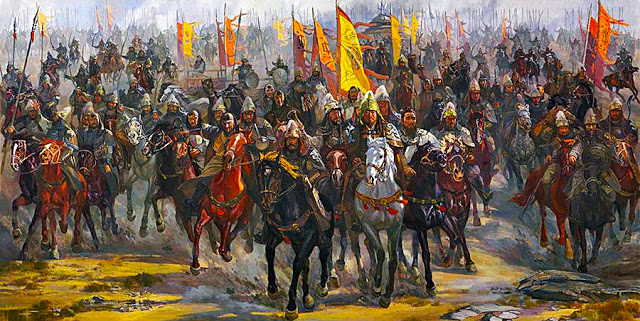An Lushan Rebellion World History
The An Lushan Rebellion was a major revolt against the Tang dynasty of China that lasted from 755 to 763 CE. It was led by General An Lushan, a former military commander of the Tang Empire. The conflict was caused by a combination of political, economic, and military factors, as well as the failure of the imperial court to adequately address the grievances of the population. The rebellion resulted in the deaths of millions of people and the destruction of many of the Tang Dynasty’s cultural and economic achievements. The rebellion also drastically weakened the Tang’s power and influence, leading to its eventual downfall. It is considered to be one of the most devastating civil wars in Chinese history.
Overview of the Lushan Rebellion
The Lushan Rebellion (also known as the An Lushan Rebellion) was a pivotal conflict in the history of China that lasted from 755 to 763 CE. It was a civil war that began when An Lushan, a general of the Tang Dynasty, rose up against the imperial government of China. The conflict was fought on a massive scale, with an estimated one million people killed during the course of the war. It was a conflict that had far-reaching consequences, not only for the Tang Dynasty but for the entire world.
The conflict began as a result of the increasing power of the Tang Dynasty’s military governors, or jiedushi. These governors had grown increasingly powerful since the Tang Dynasty was founded in 618 CE, and An Lushan was the most powerful of them all. He declared his own state in 755 CE, called Yan, and soon rose up against the imperial government of China. This sparked a civil war that would last for eight years.
The resulting war was fought on a massive scale, as forces loyal to An Lushan clashed with those of the Tang Dynasty. In 763 CE, the Tang Dynasty emerged victorious, but the war had caused tremendous destruction and weakened the dynasty. The war also led to a dramatic shift in the balance of power in the region, as many of the Tang Dynasty’s former vassals declared their independence. The war also had a major impact on world history, as it marked the beginning of a period of decline for the Chinese Empire.
Causes of the Lushan Rebellion
The Lushan Rebellion was a major uprising in China that occurred between AD 755 and 763 and resulted in the death of millions of Chinese citizens. The rebellion was caused by a number of factors, including the political and economic instability of the Tang Dynasty, the corruption of the ruling government, and the resentment of the Chinese people towards the ruling élite.
One of the main factors leading to the Lushan Rebellion was the political instability of the Tang Dynasty. In the years leading up to the rebellion, the Tang Dynasty was rife with corruption and nepotism, leading to the erosion of the government’s legitimacy. This resulted in a lack of trust among the Chinese people, who felt that the government was not doing enough to protect them.
Another factor leading to the Lushan Rebellion was the economic instability of the Tang Dynasty. During this time period, there was a high level of economic inequality, as the ruling élite held much of the wealth and power. This led to widespread anger among the common people, who felt that they were being taken advantage of.
Lastly, the Chinese people were also resentful of the ruling élite due to their oppressive policies. The ruling élite had a penchant for taking advantage of the common people, leading to a sense of resentment among the populace. This resentment eventually boiled over into the Lushan Rebellion, as the Chinese people sought to reclaim their rights as citizens.
The Lushan Rebellion was a major event in Chinese history and had a major effect on the political and economic landscape of the Chinese Empire. The rebellion was the result of a combination of factors, including the political and economic instability of the Tang Dynasty, the corruption of the ruling government, and the resentment of the Chinese people towards the ruling élite.
Impact of the Lushan Rebellion
The Lushan Rebellion of 755-763 was a defining moment in Chinese history. The rebellion, which was started by a Chinese military general, An Lushan, was a major factor in the decline of the Tang Dynasty. The rebellion resulted in the deaths of millions of people, the destruction of many cities, and the displacement of many more.
The Lushan Rebellion had a lasting impact on Chinese culture, politics, and economy. The Tang Dynasty, which had been one of the most powerful and prosperous dynasties in Chinese history, was significantly weakened by the rebellion. The Chinese economy was also weakened as the rebellion disrupted trade and caused a decrease in agricultural output. Politically, the rebellion led to the emergence of a new dynasty, the Song Dynasty, which was characterized by more decentralized government.
The Lushan Rebellion also had a profound effect on Chinese culture. During the rebellion, many Buddhist and Taoist temples were destroyed, leading to a decline in religious belief and practice. Additionally, the rebellion resulted in the displacement of many people, leading to a mixing of different cultures and the emergence of a “melting pot” of cultures in China.
Overall, the Lushan Rebellion had an immense impact on Chinese history. It weakened the Tang Dynasty, led to the emergence of the Song Dynasty, and had a lasting effect on Chinese culture, politics, and economy. It is a defining moment in Chinese history and one that should not be forgotten.
:max_bytes(150000):strip_icc()/an-lushan-and-his-troops-attack-on-emperor--ca-1770--artist--utagawa--toyoharu--1735-1814--464427033-5c3c107846e0fb00011cf8de.jpg)
Legacy of the Lushan Rebellion
The Lushan Rebellion of 755-763 was a major event in Chinese history, which saw warlords and their armies battle for control of the Tang Dynasty. It had a major impact on the political landscape of China, and its legacy can still be felt today. The rebellion was led by an ambitious warlord named An Lushan, who sought to overthrow the Tang Dynasty. The rebellion was ultimately unsuccessful, but it caused a great deal of destruction and loss of life. In addition, the rebellion had a major effect on Chinese culture and society. It led to the development of a more centralized government, and it also resulted in the introduction of new technologies such as paper money and the military technology of gunpowder. As a result, the legacy of the Lushan Rebellion remains an important part of Chinese history.
Historical Accounts of the Lushan Rebellion
The Lushan Rebellion of 755-763 AD is one of the most significant events in Chinese history, and its impact is still felt today. During this time, the Chinese empire was divided into two rival states, the Tang Dynasty and the An Lushan Rebellion. This conflict was a result of a series of revolts led by An Lushan, a Tang Dynasty general, and his followers. The rebellion was eventually quelled by the Tang forces, but it caused immense destruction and disruption to the empire.
The Lushan Rebellion has been documented by numerous historical accounts. These accounts provide vivid descriptions of the events and the effects of the rebellion on the Chinese people and their culture. The first accounts were written shortly after the rebellion, and many more were written throughout the centuries. Some of the most notable accounts include the An Lushan Chronicles, the Standard Histories of the Sui and Tang dynasties, and the Records of the Grand Historian.
All of these accounts provide valuable insights into the events of the Lushan Rebellion. They provide detailed descriptions of the battles and the motivations of the rebels, as well as the effects of the rebellion on the Chinese people. In addition, these accounts also provide a unique perspective on the culture and society of the time.
The Lushan Rebellion is a major event in Chinese history, and the accounts of the conflict provide valuable insights into Chinese culture and society. These accounts are essential for understanding the events of the rebellion and its effects on Chinese history.
Modern Relevance of the Lushan Rebellion
The Lushan Rebellion of 755–763 CE was a pivotal moment in Chinese history, forever changing the landscape of the country and its people. Although the rebellion occurred over a thousand years ago, its effects and implications are still felt in the modern day. This article will explore the modern relevance of the Lushan Rebellion, its implications for current Chinese power dynamics, and how it has shaped the country and its people today.
In terms of Chinese power dynamics, the Lushan Rebellion had a major impact on the structure of the ruling government. It resulted in the weakening of the Tang Dynasty, which had been in power for over two hundred years prior to the rebellion. This left the door open for other dynasties to rise up and take control, ultimately leading to the rise of the Song Dynasty in 960 CE. This shift in power ultimately led to a period of economic growth and cultural exchange between China and other nations.
In terms of cultural relevance, the Lushan Rebellion has left an indelible mark on Chinese culture and society. It is often lauded as a symbol of Chinese resilience and perseverance in the face of widespread destruction and chaos. As such, the rebellion has become a powerful symbol of Chinese identity, with many people celebrating its legacy and mourning its victims.
The modern relevance of the Lushan Rebellion cannot be understated. It is a reminder of the fragility of government and the power of popular uprising to reshape an entire country. It also serves as a reminder of the strength of Chinese culture and its ability to adapt and survive in the face of adversity. For these reasons, the legacy of the Lushan Rebellion lives on in modern China, and its effects will be felt for generations to come.
FAQs About the An Lushan Rebellion World History
Q1. What was the An Lushan Rebellion?
A1. The An Lushan Rebellion was a major civil war in Chinese history that took place during the Tang Dynasty in the 8th century. It was initiated by the general An Lushan, who led a revolt against the Tang Dynasty to establish his own Yan Dynasty.
Q2. How long did the An Lushan Rebellion last?
A2. The An Lushan Rebellion lasted for 8 years, from 755 to 763 AD.
Q3. What were the consequences of the An Lushan Rebellion?
A3. The An Lushan Rebellion caused massive destruction to China, killed millions of people, and weakened the Tang Dynasty. It also led to the decline of the Silk Road trade and a period of political and economic turmoil in China.
Conclusion
The An Lushan Rebellion (755-763) was a major event in Chinese and world history. It was a civil war between the Tang dynasty and the Turkic-led rebels of An Lushan and his son, Shi Siming, who declared themselves as independent rulers. The rebellion lasted for 8 years and resulted in the death of millions of people, the displacement of many more, and the weakening of the Tang dynasty. Despite its devastating consequences, the event left a lasting legacy in Chinese history. It created a new era of social and political unrest, and led to the rise of a new class of military aristocracy. The rebellion also played a role in the development of a new form of government, known as the “Three Departments and Six Ministries System”, which unified China for the next two centuries. The An Lushan Rebellion was a major event in world history, and its consequences are still felt today.





